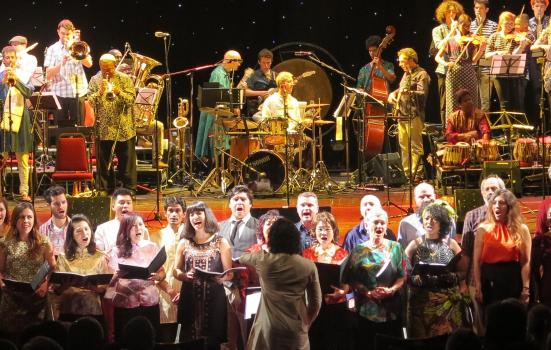Has music become too pigeon-holed into distinct genres? Tony Haynes asks how we can truly promote cultural diversity when the opportunities for creativity are so restricted.

Grand Union Orchestra
Once in a while, something happens that makes you see your work from a completely new angle. For me, a recent revelation was two-fold, and is vividly illustrated in two short video clips. First, one of Grand Union Orchestra’s big participatory shows, Undream’d Shores at the Hackney Empire in London.
And then Music Untamed, with 300 children on stage at the Fairfield Halls in Croydon.
In the first case, I realised that most of the performers were immigrants or descended from immigrant families, and in the second, out of the eight Grand Union musicians leading the project I was the only one born in Britain.
Why is this significant? Most of our core musicians are first-generation migrants, and they have skills, experiences and attitudes to music-making to pass on and share with others. Furthermore, like a myriad of other UK artists expert in different traditions worldwide, they provide a window on history, other cultures and societies that can enrich our lives and the arts in Britain today. They therefore have a crucial part to play in making the creative case for diversity, an Arts Council England priority.
A wider repertoire
Genre classifications are essentially backward-looking, convenient for characterising the art of the past, but not the present
How is this to be achieved? To begin with, let’s assume the young musicians performing in those two concerts are enthused by their experience of these and similar projects and want to continue to make this kind of music. There is a wealth of youth ensembles across the country (orchestras, jazz big bands, steel pan groups, South Asian ensembles), but they are all genre-specific – narrow in repertoire, requiring particular technical skills such as the ability to read music, and so on.
They do not provide opportunities for those who want to improvise, explore other types of music, work with players and instruments outside the European tradition, or create a repertoire of their own. Without that, these young musicians are likely to lose interest and drop out of music-making.
In other words, they need practical opportunities to learn and perform – ensembles that cross and combine genres and musical cultures, run by a variety of musicians who have the authentic expertise in different traditions. And these ensembles need a professional model.
However, a similar problem is faced by those who wish to bring together artists of different cultures – and indeed disciplines – to create professional work. New work can’t necessarily be poured into old moulds. If it embraces the artistic principles of unity of form and content, of style and idea, it’s likely that any innovative piece of work will forge its own distinct identity. It may not be easy to fund or sell, but above all it will be hard or impossible to promote or market through traditional or conventional means.
The tyranny of genre
It’s dispiriting to see how ‘what’s on’ listings pigeon-hole music by genre – classical, jazz, pop, folk, world – and then realise that your music doesn’t fit comfortably into any of these categories. Our large-scale shows contain elements of opera, musical, lyric theatre, but none of these accurately characterises their form.
It’s frustrating because these shows draw large and enthusiastic audiences from across a whole spectrum of taste and demographics, but they would appeal to much wider audiences if they could reach them – particularly among Black, Asian and minority ethnic (BAME) communities. Critics and journalists report within the same constraints (or their media masters impose them), radio and TV programmes have similar biases, and probably social media, with its now notorious algorithms, further exacerbate the difficulty of breaking through.
Thus, the tyranny of genre runs right through our arts and culture, with a tendency to stifle anything radical or progressive, and subvert progress towards cultural diversity.
Cultural diversity
The argument for cultural diversity should not be based just on a sense of equality and fairness, giving BAME citizens the chance to get influential jobs. Rather it should champion the creative contribution that artists from these communities can make to British culture, to relish and value the role they can play in enriching our performing arts. In other words, it’s about content – actually embodying diversity in the work created.
Genre classifications are essentially backward-looking, convenient for characterising the art of the past, but not the present. They also form the basis of many audience development initiatives, aimed largely at increasing attendances for existing work. But what if this were combined with product development, and coming up with new and effective ways of promoting and marketing newly minted, unclassifiable work in defiance of genre categorisation, and reaching out to new and broader audiences?
The role of leadership
This surely is where cultural leadership should come in. This tends to refer to managers, administrators, directors and producers, rather than the artists themselves. But it’s the artists who should be given the opportunity to lead, with their organisational support. That leadership should be diverse, but it does little in itself to effect profound change. It risks being merely cosmetic unless the substance of the work – and the performers and the audiences it appeals to – begin to truly reflect the whole UK demographic.
Our artistic practice has embodied these principles for years without fully realising it. Challenging it may be, but whatever the difficulties, it is the loyalty and enthusiasm of audiences and above all participants that sustains the work. They are the best ambassadors, advocates, publicists – the marketing machine.
The two videos illustrate the two poles of our current work: producing high-quality projects with, for and about Britain’s diverse communities, and music projects for young people. They are rooted in the recognition that our country’s culture is shaped by migration – and are created completely without regard to distinctions of genre.
Tony Haynes is Composer and Director of Grand Union Orchestra.
www.grandunion.org.uk
www.tonyhaynesmusic.wordpress.com





Comments
mrcuttime replied on Permalink
A Time for Everything